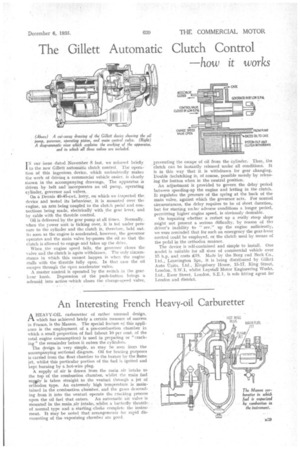The Gillett Automatic Clutch Control how it works
Page 53

If you've noticed an error in this article please click here to report it so we can fix it.
TN our issue dated November .8 last, we referred briefly 1 to the new Gillett automatic clutch control. The operation of this ingenious device, which undoubtedly makes the work of driving a commercial vehicle easier, is clearly shown in the accompanying drawings. The apparatus is driven by • belt and " incorporates an oil pump, operating cylinder, governor and valves.
On a Dennis 40-45-cwt. lorry, on which we inspected the device and tested its behaviour, it is mounted over the engine, an arm being coupled to the clutch pedal and connections being made, electrically with the gear lever, and by cable with the throttle control.
Oil is delivered by the gear pump at all times. Normally, when the cower unit is ticking over, it is fed under pressure to the cylinder and the clutch is, therefore, held out. So soon as the engine is accelerated, however, the governor operates and the main valve by-passes the oil so that the clutch is allowed to engage and takes up the drive.
When the engine speed falls, the governor closes the valve and the clutch is again withdrawn. The only circumstance in which this cannot happen is when the engine stalls with the throttle fully open. In that case the oil escapes through the open accelerator valve.
A master control is operated by the switch in the gear. lever knob. Depression of the push-button brings a solenoid into action %which closes the change-speed valve, • preventing the escape of oil from the cylinder: Thus,, the clutch can be instantly released under all condition. It is in this way that it is withdrawn for gear changing. Double declutching is, of course, possible merely by releas ing the button when in the neutral position. "
An adjustment is provided to govern the delay period between speeding-up the engine and letting in the clutch. It regulatw the pressure of the spring at the back of the main valve, against which the governor acts. For normal circumstances, the delay requires to be of short duration, but for starting under adverse. conditions a longer period, permitting higher engine speed, is obviously desirable.
On inquiring whether a restart up a really steep slope might not present a serious difficulty, by reason of th3 driver's inability to " rev." up the engine sufficiently, we were reminded that for such an emergency the gear-lever control could be employed, or the clutch used by means of the pedal in the orthodox manner.
The device is self-contained and simple to install. One model is suitable for all sizes of commercial vehicle over 15 h.p. and costs £18. Made by the Borg and Beck Co., Ltd., Leamington Spa, it is being distributed by Gillett Auto Units, Ltd., Kingsbury House, 15-17, King Street, London,' S,W.1, whilst Laystall Motor Engineering Works, Ltd., Ewer Street, London, S..1., is sole fitting agent for London and district.




























































































